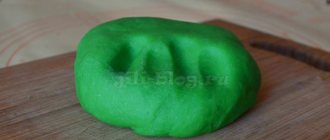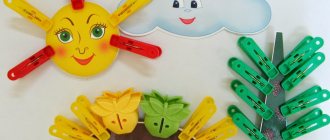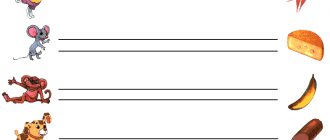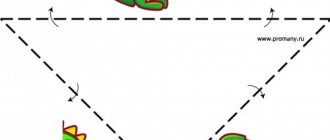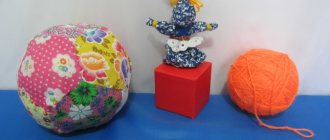Make a picture using puzzle cubes
If your child is already familiar with simple puzzles, now you can invite him to assemble a picture on puzzle cubes (of 4 parts) (Labyrinth, Ozon, My-shop). This task is a little more difficult, because here, before placing the cube in the right place, the child must also turn it and find the appropriate side. At first, of course, you will have to twist the cube to find the right side, but while you are doing this, explain to your baby why you chose one side or another.
Play with two- or three-layer insert frames (puzzles)
Multilayer frame inserts are simply amazing toys; they combine the functions of both a puzzle and a platform for a story game. As a rule, such inset frames show the child one object in different sections, for example, a house (bus, car) inside and outside. This representation of an object contributes to the development of the child’s imaginative thinking. And it’s just incredibly interesting! Even parents
For example, the puzzle “House of Hares” (My-shop, Read) consists of the following layers: on the lowest layer the bunnies woke up and got out of their beds (in this case, you can get each hare and play a small plot game with them), on the next layer the awakened hares have already begun to carry out some kind of activity: drinking tea, taking out toys, on the third layer the house is shown from the outside and you can see what the hares are doing on the street. Here are interesting options for two-layer puzzles - House or Bus.
In this game, the child learns to distinguish the details of each layer and combine them not just by the similarity of objects (as in ordinary frame inserts), but by meaning.
DIY games with clothespins
For these games you will need colored cardboard and a minimum of time. It takes a couple of minutes to cut the blank, but it will last a long time.
With the help of clothespins we attach rays to the sun , rain to a cloud , to recognize colors, we attach needles to a hedgehog. Multi-colored circle. Multicolored circle . Another of our favorite games. Its creation will take a little more time, but the results will please you.
I cut a circle out of cardboard, divided it into 6 parts, and colored each part to match the colors of the clothespins I had. I drew circles along the outer edge: from two to five. Children attach clothespins of the corresponding color according to the number of circles. The game is well suited for children learning to count.
This is what we do. There are more than enough such games. But you can come up with many other options : attaching legs and arms to little people, fingers to palms, paws to bugs, petals to flowers, legs to animals, wings to an airplane, leaves to a tree, etc.
Use a sponge to pour water from one bowl to another
The game is in many ways similar to the previous one, but still gives the child slightly different sensations. A few tips: firstly, place a bowl of water on the left and an empty bowl on the right , then the child will pour water from left to right, this direction of action is important for placing his hand before writing. Secondly, it should be noted that it is more convenient to play with a sponge that is completely soft (without a hard part); if you were unable to buy a soft sponge, then cut off the hard part with a knife.
Build paths from dominoes
This may seem surprising to some, but a one-year-old child can already play dominoes! Of course, while there is no need to explain detailed rules to the child, tell him what a “bazaar” and “fish” are, he is unlikely to be interested in this. But the domino principle itself, based on the selection of identical pictures, can easily be grasped by a child.
To play, you will need a children's domino with pictures that the baby can understand (for example, we have this, other options are Ozon, My-shop). Explain to your child that you can build paths (or fences, as you prefer) from dominoes. But the paths are not simple: the dominoes in them must be selected so that the pictures on the edges match. Taisiya and I used dominoes to build a large fence, inside of which some animal would definitely live. Tasya could play dominoes on her own for a long time.
MAGAZINE Preschooler.RF
Games with clothespins to develop children's fine motor skillsGames with clothespins are ideal for developing fine motor skills of fingers. Unfortunately, few parents know why they need to develop fine motor skills at all. The thing is that the speech and motor centers are located nearby in the cerebral cortex, hence the connection between the sense of touch and the development of speech. The more your baby feels objects (preferably of different shapes and textures), the less likely he is to have speech problems. You can make a whole clothespin theater with your own hands with such details, or the open halves of clothespins can play the role of the opening mouth of the characters.
The proposed exercise games take into account age characteristics, give children the opportunity not to experience fatigue and do not reduce interest in activities in general. These games are useful for developing fine motor skills of the fingers and precise movements of the hands, since the muscles involved constantly send impulses to the brain, stimulating the central nervous system and promoting its development.
You need to start playing with clothespins by showing the clothespins themselves and talking about why clothespins are needed in life? Have your children ever seen clothespins at home? Where do you get clothespins? Who uses clothespins at home? Then you need to distribute clothespins to the children and explain how to press and “open” the clothespins. Let the children examine the clothespins and practice opening the clothespins, stringing the clothespins on a rope, or on the walls of a box or jar. In the future, you can play the following games:
Manufacturing of gaming equipment
You need to find not very thick, but dense cardboard, print pictures on a printer and glue them to the cardboard base, and then cut them out along the contour. It is advisable to laminate the blanks for greater durability, and if you don’t have a laminator, you can simply cover them with transparent tape. All you have to do is buy clothespins of different colors (you can also take wooden ones, which you can then paint in the desired colors).
"Sun"
This clothespin game is one of the most popular. In it, the baby needs to attach rays to the sun so that it shines brightly. Various modifications of it are possible: branches for a Christmas tree, ears for a bunny, grass, wings for a butterfly, and so on, which can be suggested to parents by their imagination. Thanks to this game, the child learns to open a clothespin, training the dexterity of his fingers and fine motor skills in general.
"Pinch-pinch"
This game is suitable for the youngest children. You need to pinch the baby's palm, fingers, tummy, legs with a clothespin. During this game, he will develop tactile sensitivity, and at the same time it will be possible to study parts of the body with him.
"Fish"
You can show your baby how the “fish” (clothespins) open their mouths and ask him to feed them. Let him try to grab small objects (coins, buttons, pasta, etc.) with a clothespin. This game perfectly develops fine motor skills and hand coordination.
"Colors"
Show your child pictures with various objects, and each of them should have the same color as the color of a certain clothespin. The baby’s task is to attach clothespins to objects of the corresponding color.
"Abacus and Beads"
Together with your baby, you can make beads from clothespins by stringing them on a cord. If the child already knows the basic colors, then he can alternate the colors of the clothespins. If you stretch a string between the legs of the chairs, you can arrange something like an abacus. With the help of such a game, you can reinforce the concepts of colors, train finger dexterity, and form the basics of counting.
"Palm"
You need to cut out a palm from cardboard, but without the fingers, and explain to the baby that they are going for a walk. He needs to return them, attaching clothespins. In this game, your child will be able to learn how to select the correct number of objects.
"Beetles"
Clothespins can be attached everywhere around the room: on the carpet, toys, books, tablecloth, curtains and tell the child that these are bugs that have fled and need to be found and sent to the box house. The game helps develop attention.
"Remove the bug from your clothes"
You need to attach multi-colored clothespins to the child or yourself and invite him to remove these bugs. With the help of this fun game, you can strengthen your child’s knowledge of body parts, basic colors, clothing, and study the concept of “left” and “right ,” right and left hands. You can chase daddy with your baby, saving him from annoying bugs.
"Grass"
The child needs to be given several strips of cardboard of different lengths, explaining that these are “clearings” , on which he is invited to plant “grass” . With the help of this game, the concepts of “long” and “short” .
"Corners"
Give the child cardboard geometric shapes, to the corners of which he must attach clothespins. With the help of this game the concept of “angle” . Older children can count the number of angles and learn what polygons are.
"Constructor"
You can make a wonderful construction set from clothespins. You can collect a lot from them: funny people, an airplane, a spider, a butterfly, etc. With the help of this creative game, a child can develop his imagination.
“Who eats what?”
You need to cut out a circle and divide it into 12 sectors, in each of which you need to draw typical food for animals, and their faces need to be cut out and glued to clothespins. It is convenient to use wooden clothespins and double-sided tape, and then you can laminate the pictures. Let the baby feed these animals. With the help of this excellent educational game, a child can find out what an elephant, panda, fox or any other animal likes to eat. And there are so many other interesting things you can do with clothespins. Play for your health!
| Next > |
Cut with scissors
After 1 year 9 months, the child’s motor skills become more and more perfect, and you can already begin to introduce the child to scissors. Surely you have already heard about the famous Kumon notebooks (Labyrinth, Ozon, My-shop), which can teach any child how to cut, but if the child has never worked with scissors before, do not rush to immediately purchase notebooks and complete tasks. At the first stage, your main task is to teach your child to hold scissors correctly, open and close them, and simply introduce the child to the process of cutting paper into pieces.
First, let your child learn to make short cuts along the edge of the sheet. And only then, when his actions are more confident, offer to make several cuts in succession along the drawn line. So, before class, you can draw a few not too long lines on a small sheet of paper and invite your child to cut the sheet along these lines.
Naturally, for classes you need to purchase special children's scissors with blunt ends and it is advisable that the scissors have one ring small and the other larger. The thumb must be inserted into the small hole of the scissors, and the index and middle finger into the large one . If it is more convenient for the baby, you can also insert your ring finger into the large hole. It is also important to teach the child to correctly hold the sheet with his left hand (if the child is right-handed).
A little later, you can move on to Kumon notebooks; the unusual tasks in them stimulate the child’s interest. Taisiya, for example, developed a passion for Kumon tasks at the age of 2 years and 2 months. In parallel with the use of notebooks, you can continue to draw lines on paper, gradually complicating them: adding zigzags, waves, etc.
